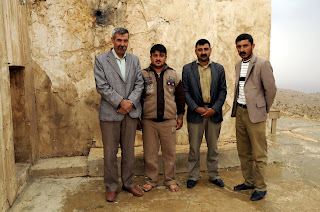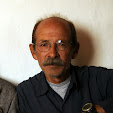April 3, 2012. Erbil, Iraqi Kurdistan
We
were sitting in the garden when 67-year old Ibrahim came out of his home, one
hand draped through the arm of his son Mohammed, the other hand gripping his
hoop-handled cane. He wore the
traditionaI Kurdish black-and-white head scarf and high-waisted loose-fitting
pants, topped by a white shirt and black sports coat. He was freshly shaved, skin radiant and
without blemish; his glasses flashed the afternoon sun. I rose from the white plastic chair and
walked across the yard entering into the dance of Kurdish greetings as I
heartily shook his hand.
 |
| Ibrahim Agha Bersirini |
Piawy!
“Piawy! Piawy! (You are a man!),” Ibrahim Agha Bersirini exclaimed through his
perpetual grin returning the handshake with surprising firmness. I still do not know why I was afforded this
prolonged and exuberant welcome, but its sincerity quickly evaporated
embarrassment.
The Bersirini home is tucked in the Brayaty ("Fraternity") neighborhood in
Erbil, Iraqi Kurdistan. As is the case
for all homes the high-walled garden area is a sanctuary from the charmless
concrete-block urban landscape. The
patch of lawn was green; the pansies, scarlet ranunculus, and Gebera daisies bloomed in the warmth of the
Mesopotamian spring.
Ibrahim suffered a debilitating stroke in 1987. It struck as the family was visiting
Ibrahim’s father-in-law to celebrate Eid,
the Muslim holiday that marks the end of Ramadan. In the night of the 4th day of the
celebration the family rushed an unconscious Ibrahim to the Erbil hospital,
some 20 km distant. A month later, after
additional treatment in Mosul, Ibrahim returned home to Brayaty to complete his recovery that never would be complete.
The stroke had paralyzed Ibrahim’s right side, and he needs
assistance for the simplest of tasks. As
evidenced by his clear and sparkling eyes his mind remains sharp. His speech, however, is largely reduced to
aspirated vowels from deep in his chest, a frustration endured by him and the
family for 25 years.
Sadiq, Ibrahim’s second oldest son, later told me, “All that we wanted since he had
the stroke was that my father would come home to live with us and not to die.
For the sake of this we went through a hard time that cannot be described.” It was
obvious that this absolute devotion continues
.
When I and Serwan Sirini (“Landslide at Mawaliyah,”
October 2009), Ibrahim’s nephew and mayor of the Rawanduz District, arrived an
hour earlier, Ibrahim was resting. We
sat in the garden with three of Ibrahim’s sons, Sadiq, Mohammed, and Ismail -
all whom spoke English - enjoying the hospitality of tea, cold drinks, and
conversation.
 |
| Sadiq, Mohammed and Ismail with Ibrahim |
It was then, and in subsequent correspondence with
Sadiq, that I learned some of Ibrahim’s story, which is yet another small window into the story of the
Kurds, and an intimate peek into the story of the man and his family.
In the
Name
Ibrahim Agha Bersirini - so much in a name. As used by the Kurds, agha can be roughly translated as “chieftan.” The Kurds are traditionally a tribal society,
with allegiance and tribute bestowed to its leader. Tribal loyalty was and is superseded only by
loyalty to family and clan. As the Kurds
gradually adopted more sedentary agriculture through the millennia, the relationship
between aghas and tribal members also
became feudal, a trait that has been consistently exploited by a parade of dominant
political powers. Ibrahim’s father Aziz
Agha held the stature of a traditional agha,
but modernity has eroded the economic and social fidelity
. Ibrahim has none of the duties or
authority of a traditional agha, but
he continues to bear the title as a sign of respect and affection. His name in conversation is a union with this
prestige - “Braimagha.”
Bersirin (“Heroes Arrive Unexpectedly,” October
2010) is a village deep in the Zagros Mountains, close to the Iranian
border. Up until 1975, Ibrahim lived
there with his wife, owning a small restaurant and renting out farmland and
pasturage to Kurdish farmers. Ibrahim
was also an early member of Mustafa Barzani’s Kurdish Democratic Party (KDP)
and had been a peshmergha (armed Kurdish fighter), wounded in a 1973 air
attack in a nearby village.
This known life, as tumultuous as it had been, came
to an end in the spring of 1975 when Iran and Iraq signed the U.S.-brokered Algiers Agreement. The immediate result was that with no
advance notice, Iran and the U.S. abruptly ended their support for Barzani’s
war for independence against Iraq’s Baathist central government, leaving the
Kurds effectively defenseless against Saddam Hussein’s military onslaught. It was a familiar situation for the
Kurds. Following Barzani's lead, Ibrahim and his family joined
upwards of 250,000 Iraqi Kurds who fled as refugees to Iran. He would remain in the Sawa refugee camp for
4 years before returning to Iraq, but not to Bersirin.
 |
| Ibrahim with children, Iran 1979 |
Even before 1975, among the Kurds in his own
village, Ibrahim had not been safe.
During this period of the evolution of Kurdish political parties,
Ibrahim was the sole member of the KDP in Bersirin. His
efforts to recruit others to join the KDP resulted in three Kurdish
assassination attempts by rival political interests.
His return to Iraq offered little relief from
fraternal enmity. Kurdish politics in
northern Iraq were ruthless, especially after the 1992 establishment of the
“no-fly” zone in the wake of the first Gulf War. The rivalry between Barzani’s KDP and Talabani’s
Patriotic Union of Kurdistan (PUK) resulted in a savage 4-year internecine
civil war and unholy alliances with erstwhile enemies such as Saddam
Hussein. A result was that homes and
lands of many early loyalists were confiscated by others within the political
structure, including Ibrahim’s holdings in Bersirin. His petitions for reparation remain
unanswered to this day.
In
the Garden
As Serwan and Sadiq were engaged in a private conversation, I sat next to Ibrahim answering his questions divined by
Mohammed. Leleekhan, Ibrahim’s wife,
quietly joined us in the garden wearing a black chador and beatific smile. We all rose to in greetings, and I vacated my
seat for her. Her face carried the
patience and endurance of caring for her husband and raising a family.
 |
| Leleekhan |
Leleekhan bore Ibrahim seven children – an oldest
daughter and six boys. All have pursued
higher education ranging from biology to engineering to Sharia law. One was studying in Australia at the time of
my visit.
Serwan stood up, signaling that it was time to
leave. He still had several visits to
make in Erbil before we drove to Rawanduz later that evening. Ismail helped his father to his feet. Ibrahim took my hand in the two of his, the
left still loosely holding plastic prayer beads. I promised I would try to return. I was once again being humbled by the
graceful tenacity and loyalty of the Kurds who have routinely endured hardships
that would defeat others.
In
the Heart
“We never
let [my father] feel weak because he is paralyzed. That is why he always acted with us in normal
way. We share jokes and he often smiles and laughs when we remind him of his
past life as often we try to bring joy to him. We serve him not as a task but
as fun. We love him. We always feel our father has a particular charm [that]
made him lucky and make us feel happy and proud to have such
father. “ Sadiq Bersirin
[I give special thanks to Sadiq Bersirini for his kindnesses and patience in responding
to my many emailed questions, and to Serwan Sirini for his years of
friendship.]
 |
| Serwan & Sadiq |
































